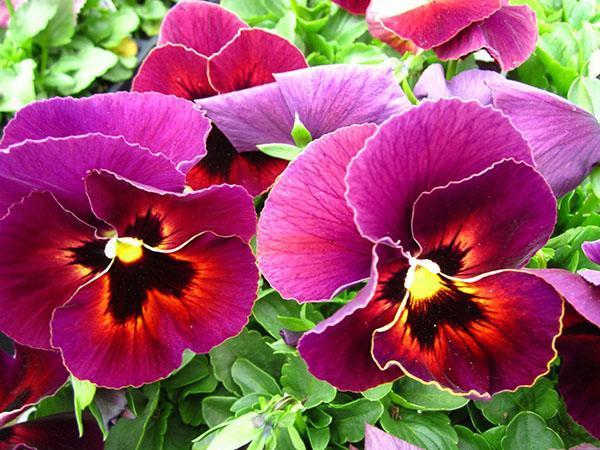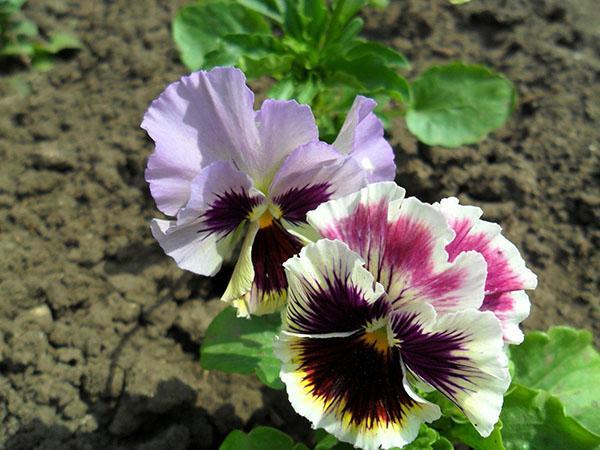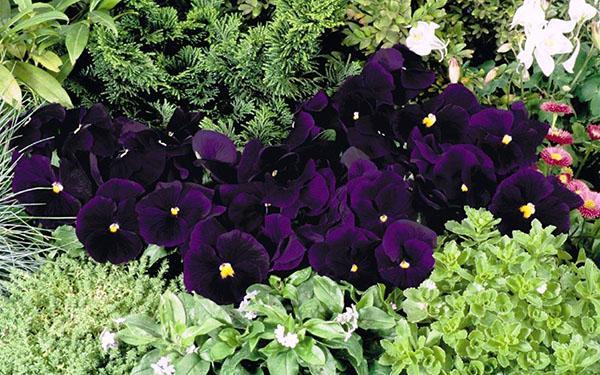Growing viola - Josephine's favorite flower
 It is difficult to find a plant in the garden that is less demanding to the conditions of its development than cute curly bushes with flower eyes. The cultivation of viola is possible even for a person who first poured seeds into the palm of his hand for sowing.
It is difficult to find a plant in the garden that is less demanding to the conditions of its development than cute curly bushes with flower eyes. The cultivation of viola is possible even for a person who first poured seeds into the palm of his hand for sowing.
The name of the plant is a tracing translation of the Latin name of the genus Violet (Viola). For centuries, fragrant flowers have been adored in many countries, especially by the French. Emperor Napoleon never returned home to his Josephine without her favorite bouquet of violets. And the great Goethe always went for a walk with a bag of viola seeds and sowed them all over the vicinity of Weimar.

- fragrant,
- horned,
- nursing,
- labrador,
- canine,
- pubescent,
- Korean,
- tricolor,
- Wittrock,
- ampelous,
- Williams and others.
The plant is very easy to cultivate, but a florist who decides to plant it in his flower bed needs to know certain rules of agricultural technology.
Growing viola in the garden
 There are several ways to plant a cute flower in your garden. The most common is sowing seeds, which is carried out both in open ground and for seedlings. Varietal viols are propagated by the vegetative method using cuttings and layering.
There are several ways to plant a cute flower in your garden. The most common is sowing seeds, which is carried out both in open ground and for seedlings. Varietal viols are propagated by the vegetative method using cuttings and layering.
The site for planting is chosen sunny, with loose and humus-rich loamy soil, well fertilized with potassium and phosphorus.
Sowing seeds in open ground
 Reproduction of viola by seeds is used more often as a simpler and less costly opportunity to grow a flower. If you sow seeds for seedlings, then flowering can be expected already in the current season. Seeds sown in open ground will produce plants that will bloom next spring.
Reproduction of viola by seeds is used more often as a simpler and less costly opportunity to grow a flower. If you sow seeds for seedlings, then flowering can be expected already in the current season. Seeds sown in open ground will produce plants that will bloom next spring.
Viola is planted in open ground in May-June, when the threat of recurrent spring frosts has already disappeared. Sowing is carried out sparsely, in rows and the seeds are embedded in the soil by no more than 1 cm. Seedlings appear in 10-15 days. If the weather is dry, they are lightly watered so as not to wash off the pressure of water. The soil between the rows is loosened and weeds are removed.
When the seedlings grow up, they are thinned out, leaving a distance of 7-10 cm between neighboring flowers. It is also possible to pick seedlings in 3-4 weeks on the beds where the viola will winter. The first time after the pick, the plant is shaded.
Sowing seeds for seedlings
 The timing of planting viola for seedlings depends on when they plan to wait for flowering. If sown in late January or February, then the bushes will delight with buds at the end of May. The March sowing will produce flowers in late summer.
The timing of planting viola for seedlings depends on when they plan to wait for flowering. If sown in late January or February, then the bushes will delight with buds at the end of May. The March sowing will produce flowers in late summer.
Shallow seedling bowls are filled with purchased soil, which is spilled with a slightly pink solution of potassium permanganate on the eve of sowing. Small viola seeds are laid out in shallow grooves, barely sprinkled with earth. Sprinkle with water from a spray bottle, cover the crops with plastic wrap on top and put on the windowsill southwest window.
The mini-greenhouse is regularly ventilated and humidified. Seedlings appear after 10-14 days. In early April, they dive into larger pots, deepening to the cotyledonous leaves. At the end of this month, they begin to harden the seedlings, exposing them in the afternoon to an unglazed balcony or a veranda, and at night returning to the room. In open ground, seedlings are planted in the first or second decade of May, maintaining a distance of 15-20 cm between them. At the beginning of June, the viola is already blooming.
Advice from experienced florists on how to beautifully plant a viola: if, when planting seedlings on a garden bed, part of the plants is placed in the shade, and the rest in a lighted place, then flowering is prolonged.
Those in the sun dissolve their petals earlier, which receive less illumination - they bloom later and wither after all the others.
Reproduction of viola by cuttings and layering
 Especially valuable varieties are propagated vegetatively. Cuttings are cut from May to July from well-developed healthy plants. To do this, use apical shoots with 2-3 internodes. They plant them on a shaded garden bed close to each other so that they touch. The groove is well spilled with water and the cuttings are buried by about 0.5 cm. Spray on top and cover with foil. After 3-4 weeks, you can already check which roots the viola has. Usually, plants develop a good root system by this time.
Especially valuable varieties are propagated vegetatively. Cuttings are cut from May to July from well-developed healthy plants. To do this, use apical shoots with 2-3 internodes. They plant them on a shaded garden bed close to each other so that they touch. The groove is well spilled with water and the cuttings are buried by about 0.5 cm. Spray on top and cover with foil. After 3-4 weeks, you can already check which roots the viola has. Usually, plants develop a good root system by this time.
For reproduction by layering, the plant is shaded so that it stretches. In early autumn, the shoots are bent to the ground and sprinkled with fertile soil. By spring, the layers take root and are transplanted to the garden bed.
Viola planting in a permanent place before winter is carried out in early September by transshipment. Rooted bushes are covered with dry fallen leaves to protect them from freezing. In winter, they make sure that during thaws, water does not stagnate in the beds with wintering viols.
Growing and caring for a viola flower in a pot
 The grown seedlings in May are transferred into flower containers, which are placed in patio, on the terrace or hung in a planter. Violet loves moisture, but will get wet from stagnant water. Consequently, a drainage layer is required at the bottom of the pot, for example, from expanded clay or gravel. Any commercial and fertile soil is suitable for viola. However, containers can also be filled with ordinary garden soil mixed with humus, and for looseness add a little coarse river sand.
The grown seedlings in May are transferred into flower containers, which are placed in patio, on the terrace or hung in a planter. Violet loves moisture, but will get wet from stagnant water. Consequently, a drainage layer is required at the bottom of the pot, for example, from expanded clay or gravel. Any commercial and fertile soil is suitable for viola. However, containers can also be filled with ordinary garden soil mixed with humus, and for looseness add a little coarse river sand.
Plants are moisturized regularly, avoiding drying out. On the eve of a long absence of the grower, watering is also possible in the pallet. Weekly viols are fed with any universal fertilizer for flowers. With this care, they open the buds almost all summer.
How to care for viola in the garden
 The main measures for the care of the viola in the garden are the timely loosening of the soil, especially after rain, it is necessary to weed out and destroy the crust on the ground, which prevents air from penetrating to the roots. Simultaneously with weeding, weeds are removed from the feeding zone of the viola bushes.
The main measures for the care of the viola in the garden are the timely loosening of the soil, especially after rain, it is necessary to weed out and destroy the crust on the ground, which prevents air from penetrating to the roots. Simultaneously with weeding, weeds are removed from the feeding zone of the viola bushes.
Watering and feeding
 The plant is quite hygrophilous, but it gets wet from excess moisture in a particularly rainy summer if it ends up in a lowland, constantly flooded with puddles. However, the viola should not suffer from a lack of moisture, otherwise the flowers become smaller, the growth of the bushes slows down, the flowering may stop altogether. In too much heat, flower buds do not form.
The plant is quite hygrophilous, but it gets wet from excess moisture in a particularly rainy summer if it ends up in a lowland, constantly flooded with puddles. However, the viola should not suffer from a lack of moisture, otherwise the flowers become smaller, the growth of the bushes slows down, the flowering may stop altogether. In too much heat, flower buds do not form.
The first feeding during the cultivation of viola is done on the eve of budding - a tablespoon of nitrophoska is added to a bucket of water. The second time is fed during flowering with fertilizer "Agricola-7", diluting 1 tablespoon in 10 liters of water. The solution is poured over the plants under the root.
After the flowers wither, the stems are cut, leaving 10-12 cm from the ground level, the bushes are abundantly watered and fed. Very soon, new young shoots grow, on the tops of which flowers appear again.
How to collect viola seeds
The time to collect the seeds comes when the top of the seed pod turns white or yellow, and it rises up on the peduncle. Plucked at this moment, they ripen well during drying in a shaded place with active air circulation. Viola seeds retain their germination for 2-4 years. 1 g contains about 800 pieces.
Viola diseases and the fight against them
 Many growers claim that viola is resistant to disease and pests. However, this remark is more true for natural species, but varietal plants are more vulnerable to problems in care.
Many growers claim that viola is resistant to disease and pests. However, this remark is more true for natural species, but varietal plants are more vulnerable to problems in care.
Most garden viols suffer from blackleg disease and powdery mildew in high humidity conditions. In order to prevent blackening of the base of the stem, experts recommend not to thicken the planting and disinfect the soil by sprinkling with a solution of potassium permanganate or foundation. Powdery mildew is treated with a solution of soda ash and laundry soap.
Leaf spot is often threatened by Wittrock's viola. Process it Bordeaux liquid or a copper-soap preparation. Viola tricolor and fragrant from ascochitis is sprayed with copper-containing agents. Phylosticosis most often occurs on Williams' viola and ampelous plants. Treatment before flowering with Bordeaux mixture or preparations "Abiga-Peak", "Hom" helps to save plantings from it.
Affected by pythium (root rot of seedlings) or gray rot, tricolor, ampelous and fragrant viola plants are destroyed along with the clod of earth where they grew. The soil under the neighboring healthy bushes is spilled with solutions of "Maxima" or "Alirin-B".
Those who are sick with fusarium, late blight or variegation of the Wittrock violet, fragrant, Williams and tricolor cannot be cured. Spores of fungi live in the soil for a long time and it is no longer recommended to plant viola in the garden where the defeat occurred. To avoid viral infection, the plant is not planted near cucumber and pumpkin beds.
Viola pests and how to get rid of them
 The parasitic fauna most of all annoys the Wittrock violets and the tricolor. During the cultivation of viola, there are:
The parasitic fauna most of all annoys the Wittrock violets and the tricolor. During the cultivation of viola, there are:
- spider mites in very dry weather;
- spring earthworm eating up points of growth and roots of plants;
- mother-of-pearl - large forest or Pafia, whose caterpillars gnaw all parts of the flower;
- checkerboard maturna - its larvae eat leaves;
- gall nematode parasitizes on the roots, forming swellings with egg-laying - galls.
Systemic insecticides are used against insects, ticks are removed with the help of acaricides, and to prevent the appearance of nematodes, sodium nitrate is introduced into the soil a week before planting - 150-200 g per 1 sq. m.
Planting and caring for a viola in the open field does not cause too much trouble for the grower. But the amicable flowering of cheerful bushes, accompanied by a fragrant aroma, brings a lot of positive emotions throughout the summer.